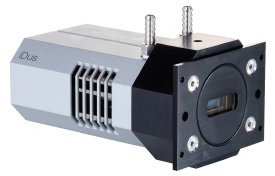May 25 2011
Nanoscale antennas hold out the promise of higher resolution optical imaging of nano objects, including proteins and DNA molecules, and converting solar energy into electricity at very high efficiencies. Now, a team from the University of Illinois led by Nicholas Fang and Kimani Toussaint has demonstrated a 1,000-fold increase in the UV-Visible optical response of devices based on nanoantennas periodic arrays.
First proposed by Robert L. Bailey in 1972, nanoantennas are analogous to radio and microwave antennas, except that they can absorb a specific range of wavelengths of light dependant on their geometry and size. Bowtie NanoAntennas consist of two triangular pieces of gold with their tips facing each other in the shape of a miniature bowtie. They take energy from the illuminating beam and compress it into the nanometre gap separating the two triangles. The result is a concentrated spot of light that is many times more intense than the incoming laser beam.
 The Andor iDus CCD Camera System.
The Andor iDus CCD Camera System.
Fang and Toussaint’s team fabricated 50 nm thick gold Bowtie NanoAntenna (BNA) composed of two equilateral triangles with 140 nm sides separated by a 20 nm gap and acquired the emission spectra when illuminated with 780 nm laser light using an Andor iDus DU420A-BU camera. When individual antennas were gathered into arrays with 500 nm centre-to-centre spacing, they found that the large local intensity enhancement of the single BNA was boosted by a factor of 1,000. More importantly, resonantly excited arrays exhibited uniform emission over a spectral region of more than 250 nm. The team believes that optimisation of the nanoantenna array periodicity may lead to even further efficient devices.
Recent studies have also suggested the possible development of nanoantenna-based solar energy collection devices with conversion efficiency up to 80 % - compared to 20% for traditional solar cells - as well as the use of nanoantennas arrays as nanoscale light sources to scan and image biological molecules or synthetic nano-objects such as carbon nanotube bundles.
Antoine Varagnat, Product Specialist at Andor, commented that “NanoAntennas have come under greater scrutiny over the last few years, due to their potential to provide nanoscale, cost-effective optical probing or high-efficiency collection devices. Andor’s iDus CCD platform is ideally suited to the study of the key mechanisms at the origin of nanoantennas unique properties, namely nonlinear Second Harmonic Generation (SHG) and complex photoluminescence. iDus’ high UV to Near-Infrared response, ultra low noise and high dynamic range allow the analysis of a wide range of intensities of these broadband phenomena, providing the accurate information essential to the fine-tuning and optimization of the amplification properties of these nanoantennas. And iDus “BU” UV-enhanced back-illuminated CCD was just the right choice for the team’s 350 to 660 nm detection requirement.”
Andor’s modular Spectroscopy solutions encompass a wide range of high performance CCD, ICCD and EMCCD detectors, as well as a comprehensive range of Research-grade spectrograph platforms.